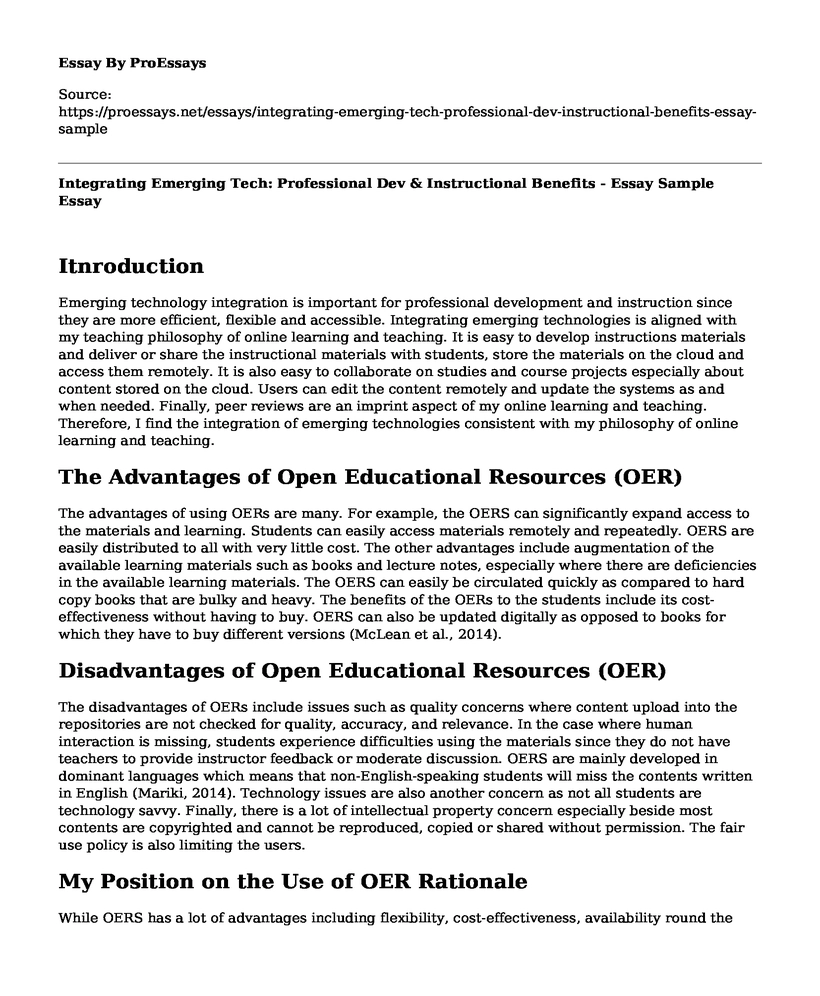Itnroduction
Emerging technology integration is important for professional development and instruction since they are more efficient, flexible and accessible. Integrating emerging technologies is aligned with my teaching philosophy of online learning and teaching. It is easy to develop instructions materials and deliver or share the instructional materials with students, store the materials on the cloud and access them remotely. It is also easy to collaborate on studies and course projects especially about content stored on the cloud. Users can edit the content remotely and update the systems as and when needed. Finally, peer reviews are an imprint aspect of my online learning and teaching. Therefore, I find the integration of emerging technologies consistent with my philosophy of online learning and teaching.
The Advantages of Open Educational Resources (OER)
The advantages of using OERs are many. For example, the OERS can significantly expand access to the materials and learning. Students can easily access materials remotely and repeatedly. OERS are easily distributed to all with very little cost. The other advantages include augmentation of the available learning materials such as books and lecture notes, especially where there are deficiencies in the available learning materials. The OERS can easily be circulated quickly as compared to hard copy books that are bulky and heavy. The benefits of the OERs to the students include its cost-effectiveness without having to buy. OERS can also be updated digitally as opposed to books for which they have to buy different versions (McLean et al., 2014).
Disadvantages of Open Educational Resources (OER)
The disadvantages of OERs include issues such as quality concerns where content upload into the repositories are not checked for quality, accuracy, and relevance. In the case where human interaction is missing, students experience difficulties using the materials since they do not have teachers to provide instructor feedback or moderate discussion. OERS are mainly developed in dominant languages which means that non-English-speaking students will miss the contents written in English (Mariki, 2014). Technology issues are also another concern as not all students are technology savvy. Finally, there is a lot of intellectual property concern especially beside most contents are copyrighted and cannot be reproduced, copied or shared without permission. The fair use policy is also limiting the users.
My Position on the Use of OER Rationale
While OERS has a lot of advantages including flexibility, cost-effectiveness, availability round the clock and efficiency, I find them less effective, poorly curated and not adequately moderated. Until the OERS are adequately moderated, created and checked for quality and accuracy, they should only be used as supplementary materials (Owen, & Dunmill, 2014).
Statement on Plan to Use OER in Online Courses or Training
I plan to use the OERS in my online course and training but I will only use them as supplementary material. I find it quite easy and effective using printed books for studies and training as competed to OERs.
Conclusion
Use of Open Educational Resources is a good idea at this advanced stage that learning has reached as long as students us texts from licensed sites, this curbs the problem of using biased information as materials of learning. I would use Open Educational Resources since it is a quick way of obtaining information, provided the information it entails is legitimate.
References
Choy, C., & Oo, P. (2012). Reflective thinking and teaching practices: A precursor for incorporating critical thinking into the classroom? International Journal of Instruction, 5(1), 168-181. Retrieved 18 April 2020, from.
Killham, J., Tyler, S., Venable, A., & Raider-Roth, M. (2014). Mentoring in an Online Simulation: Shaping Preservice Teachers for Tomorrow's Roles. Teaching & Learning: The Journal of Natural Inquiry and Reflective Practice, 28(2), 62-79. Retrieved 18 April 2020, from.
Mariki, B. (2014). Teachers' Experiences in Educational multi-Media Content Development: The Case of Tanzania's Institute of Adult Education. Turkish Online Journal of Distance Education, 15(4), 181-186. https://doi.org/10.17718/tojde.18424
McLean, F., Dixon, R., & Verenikina, I. (2014). Bringing it to the teachers: Building a professional network among teachers in isolated schools. Australian And International Journal of Rural Education, 24(2), 15-20. Retrieved 18 April 2020, from.
Owen, H., & Dunmill, M. (2014). The Long Journey: Developing a Model of PLD for the Future. Australian Journal of Teacher Education, 39(1), 117-132. https://doi.org/10.14221/ajte.2014v39n1.9
Cite this page
Integrating Emerging Tech: Professional Dev & Instructional Benefits - Essay Sample. (2023, May 22). Retrieved from https://proessays.net/essays/integrating-emerging-tech-professional-dev-instructional-benefits-essay-sample
If you are the original author of this essay and no longer wish to have it published on the ProEssays website, please click below to request its removal:
- The Use of IoT and Technology in E-mental Health: Literature Review
- Should Children Carry Cell Phones To School? - Essay Sample
- Clinical and Mental Health Counseling Admission Essay
- Cultural Awareness at American River College
- Essay Example on University Students Need Feedback: Gaining Writing Skills & Ideas
- NMR Spectroscopy: Introduction to Spin, Energy Levels and Radiation Absorption - Essay Sample
- Essay on Tech-Innovated Education: Dubai Private Schools Lead the Way







